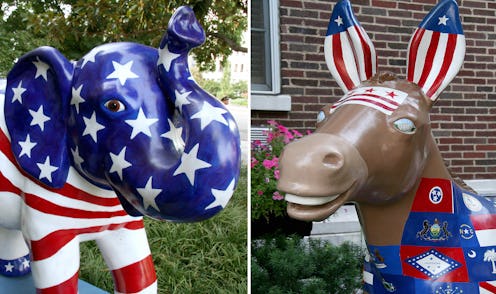With the election less than a week away, it's fair to say that everybody is talking about politics. No matter what side of the aisle you sit on, we're all following the news and eagerly awaiting the announcement of who our next President will be. Amid all the politics talk, you might wonder: Why are the donkey and elephant symbols for our political parties here in the United States? And what do those symbols mean? Let's take a closer look, thanks to a recent video from the ever-informative YouTube Channel, Today I Found Out.
Most of us are already super familiar with the cartoon-y depictions of elephants and donkeys used to represent our two major political parties, but the reasons why these images have lasted so long aren't necessarily obvious. We know that when we see a donkey, we're usually thinking of the Democratic party; similarly, when we see an elephant, Republicans immediately pop into our minds. There are plenty of good and bad associations with each of these animals, of course: Donkeys are often described as unintelligent "jackasses," but are also loyal, hard-working, and literally transport people and things from one place to another. Elephants, on the other hand, are frequently seem as clumsy and out of place, but are also bright, sensitive, and close to their families and communities.
But when these associations become tied with our major political parties? I've broken down Today I Found Out's video for the highlights below; you can also watch the full video here:
It All Began With An Insult...
American history is relatively short, but we do have to journey pretty far back to get to the bottom of this quandary. As Simon Whistler explains in the video, back in 1828, John Quincy Adams and Andrew Jackson ran against one another for President... and it was messy. And as is the case with pretty much all messy political situations, there were some serious insults being swapped between the candidates. Adams called Jackson a "jackass," meant to compare him to a dumb, stubborn animal.
...And Then The Reclamation Of That Insult
Not one to simply walk away from an insult, Jackson twisted the "jackass" comment into a positive notion for his campaign. Jackson's whole platform was about being a politician for the people — you know, the average working class person who desperately needed representation in the government. As Jackson spun it, a "jackass" represented persistence, loyalty, and the ability to carry a "heavy load." Even better? Donkeys symbolize working class people, so the donkeys started appearing in his campaign speeches, posters, and so on. Basically, a (donkey) star was born.
A Super Famous Political Cartoon Followed...
The elephant symbol came a little later, during the 1864 Presidential election in a pro-Lincoln newspaper. The elephant first appeared as a cartoon image, depicted as holding a white banner to celebrate Union victory. This played into the common phrase "seeing the elephant," which refers to "seeing the world at great cost."
...And The Rest Was History
In 1874, famous cartoonist Thomas Nast ultimately popularized both symbols in issues of Harper's Bazaar, and they spread like proverbial wildfire from there. In political cartoons, campaign slogans, posters, and even just casual discourse, people quickly recognized donkeys to represent Democrats and elephants to recognize Republicans. And as we know today, the images have stuck with us hard.
Watch the full video above for more — and definitely get out there and vote on Nov. 8!
Images: Getty Images; TodayIFoundOut/YouTube (4)
